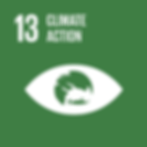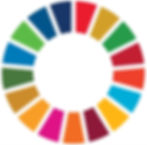The Meaning of Colors and Icons of the Sustainable Development Goals - SDGs
- Javier Trespalacios
- May 28
- 7 min read
The Sustainable Development Goals (SDGs) were adopted in 2015 by the United Nations General Assembly as part of the 2030 Agenda. Beyond their technical content, the SDGs are distinguished by a visual system based on colors and icons that identify and communicate them universally. This graphic language was designed to clearly convey the values and urgency of each goal, allowing people from different cultures to understand their message immediately (United Nations, 2015).
Origin and Design of the Icons
The graphic design of the SDGs was handled by the UN Global Communications Division, in collaboration with the agency Trollbäck + Company and its founder, Swedish designer Jakob Trollbäck.
Jakob Trollbäck, designer of the SDG visual identity. Source: The New Division. https://www.thenewdivision.world/sv/jt-forelasningar
The intention was to create a unified visual language, with striking colors and simple icons, that could be easily reproduced in global and local campaigns. The icons were conceived as schematic representations, capable of conveying both general ideas and concrete actions (MunImpact, 2019; United Nations Department of Global Communications, 2018).
Each symbol was designed with three criteria:
Universality: Understandable to diverse audiences and different cultures.
Simplicity: Reduction to basic and clear forms, avoiding complex details that would hinder recognition.
Chromatic association: Each color reinforces the meaning and identity of the goal.
An example of this design philosophy is SDG 4 (Quality Education), whose icon changed from a graduation cap to an open book with a pencil, a clearer and more universal symbol (MunImpact, 2019).
Meaning of SDG Colors and Icons
SDG 1 (No Poverty) uses an intense red that conveys urgency and calls for immediate action against poverty. Its icon represents a family, evoking social protection and the need to guarantee minimum conditions for a dignified life for all people.
SDG 1 (No Poverty)
SDG 2 (Zero Hunger) is identified with a mustard yellow, a color that evokes cereals and abundance. The icon is a deep bowl with three spikes representing steam, symbolizing food security and nutrition for all.

SDG 2 (Zero Hunger)
SDG 3 (Good Health and Well-being) uses bright green, a symbol of life, vitality, and hope. Its icon is an electrocardiogram line that ends in a heart, representing health, vitality, and constant monitoring of physical well-being.
SDG 3 (Good Health and Well-being)
SDG 4 (Quality Education) is identified by a burgundy red, a tone that inspires seriousness and transformation. Its icon is an open book with a pencil, symbolizing literacy, access to knowledge, and education as an essential tool for development and equity.
SDG 4 (Quality Education)
SDG 5 (Gender Equality) is distinguished by a strong orange, symbol of energy, social change, and the transformation necessary to achieve gender equity. Its icon combines the female and male signs with an equality symbol, reflecting the goal of eliminating discrimination and promoting equality between women and men.
SDG 5 (Gender Equality)
SDG 6 (Clean Water and Sanitation) is represented by light blue, a color directly associated with water and purity. Its icon is a glass with water and a drop, symbolizing access to drinking water and recognizing water as an essential resource for the life and health of all people.
SDG 6 (Clean Water and Sanitation)
SDG 7 (Affordable and Clean Energy) uses bright yellow that evokes sunlight as a source of clean energy. Its icon is a stylized sun that symbolizes the transition to sustainable sources. The rays represent the diffusion and availability of this energy for everyone everywhere.
SDG 7 (Affordable and Clean Energy)
SDG 8 (Decent Work and Economic Growth) is recognized by a dark red that conveys strength and dynamism. Its icon is an ascending arrow over growth bars, symbolizing progress, prosperity, and sustainable economic growth.
SDG 8 (Decent Work and Economic Growth)
SDG 9 (Industry, Innovation and Infrastructure) uses intense orange, a color associated with modernity and creativity. Its icon shows three connected cubes representing infrastructure, industry, and innovation, fundamental pillars for sustainable and resilient economic development.
SDG 9 (Industry, Innovation and Infrastructure)
SDG 10 (Reduced Inequalities) is presented with fuchsia pink, a color that symbolizes inclusion and diversity. The icon is a set of arrows pointing in opposite directions, representing existing disparities and inequalities, while the equality symbol in the center reflects the goal of achieving equality and equity for all.
SDG 10 (Reduced Inequalities)
SDG 11 (Sustainable Cities and Communities) is represented by ochre yellow that conveys urban energy. Its icon shows three structures that reflect architectural diversity: a tall building with rectangular windows representing dense urban areas, a house with a gabled roof symbolizing residential communities, and an intermediate building suggesting public or institutional infrastructure. This composition symbolizes coexistence and diversity among different types of human settlements.
SDG 11 (Sustainable Cities and Communities)
SDG 12 (Responsible Consumption and Production) uses a sandy gold, a color that evokes the cycles of nature. Its icon is an infinity symbol formed by arrows, representing circular and sustainable consumption cycles, emphasizing the importance of reducing, reusing, and recycling to preserve natural resources and protect the environment.
SDG 12 (Responsible Consumption and Production)
SDG 13 (Climate Action) adopts dark green, a color linked to nature and environmental responsibility. Its icon shows planet Earth with an eye, symbolizing the urgency of monitoring and acting against climate change to protect the planet and guarantee a sustainable future for all people.
SDG 13 (Climate Action)
SDG 14 (Life Below Water) is identified with navy blue that reflects the oceans and their depth. Its icon, representing a fish swimming among stylized waves, symbolizes marine biodiversity that must be protected to ensure the health of aquatic ecosystems and life on Earth.
SDG 14 (Life Below Water)
SDG 15 (Life on Land) uses light green, a color associated with nature and biological diversity. Its icon, a tree accompanied by natural elements, represents forest life and the ecosystems that sustain biodiversity.
SDG 15 (Life on Land)
SDG 16 (Peace, Justice and Strong Institutions) is represented by cobalt blue, a color that conveys trust and stability. Its icon, a dove with an olive branch alongside a judge's gavel, symbolizes peace, justice, and the need for solid, transparent, and inclusive institutions.
SDG 16 (Peace, Justice and Strong Institutions)
SDG 17 (Partnerships for the Goals) is represented in sky blue, symbolizing openness and cooperation. Its icon is a circle of interlocking rings, reflecting global collaboration and the need to unite efforts from all sectors and countries to achieve the set of 2030 Agenda goals.
SDG 17 (Partnerships for the Goals)
The SDG Color Wheel
The color wheel is a symbol that brings together the 17 colors in a circle. It was designed as a universal emblem to make visible the commitment to the 2030 Agenda. Each color maintains its relationship with an SDG, but being arranged in a circle, they symbolize unity, interdependence, and indivisibility of the goals. No SDG can be achieved in isolation, and the wheel represents this comprehensive vision (United Nations, 2018).
This symbol has become a global communication element: it appears at international conferences, companies, universities, and social organizations as a badge of collective commitment.
Guidelines and Usage Standards
The UN published in 2018 and updated in 2023 the guidelines for using the logo, color wheel, and icons of the Sustainable Development Goals (SDGs). These resources are available in the organization's six official languages: Arabic, Chinese, Spanish, French, English, and Russian (United Nations, 2023).
The UN emblem is for exclusive use by entities of the United Nations system. In contrast, the icons and color wheel can be used by institutions, organizations, or individuals without the need for authorization, provided their visual integrity is respected and institutional endorsement is not suggested (United Nations, 2018).
The use of symbols is permitted free of charge in educational materials, awareness campaigns, and public events. For commercial or advertising purposes, such as merchandising or corporate marketing, express authorization is required, and any association with political propaganda, unauthorized fundraising, or misleading messages is prohibited (United Nations, 2018).
Conclusions
The SDG graphic system combines colors, icons, and the wheel as a universal language that translates complex concepts into clear images. Understanding the meanings of each color and symbol, as well as usage standards, allows these elements to be leveraged in education, communication, and global awareness actions without violating rights. The SDGs thus become both a symbolic and practical instrument for promoting sustainability worldwide.
References
Dkdndes. (n.d.). SDG Colors. GitHub Gist. https://gist.github.com/dkdndes/7dd37498225a0461f7f52682137791c4
MunImpact. (2019). A look into the SDG logo design process. Model United Nations Impact. https://munimpact.org/a-look-into-the-sdg-logo-design-process/
United Nations. (2015). Transforming our world: The 2030 Agenda for Sustainable Development. United Nations General Assembly.
United Nations Department of Global Communications. (2018). Branding the SDGs: Guidelines for the use of the SDG logo, including the colour wheel, and 17 icons. United Nations.
United Nations. (2018). Guidelines for the use of the SDG logo, including the colour wheel and 17 icons. United Nations Department of Global Communications.
United Nations. (2023). SDG Logo and Branding Guidelines (updated edition). New York: United Nations Department of Global Communications.
Trollbäck + Company. (2016). The global goals identity system. New York: Trollbäck + Company.
*****
Bonus track
Eva is drawing the SDGs
Colombian artist Rubén Trespalacios has brought the 17 Sustainable Development Goals (SDGs) to life by gathering them in a single pictorial work where each icon and color are identifiable and symbolic. His painting, currently exhibited in Basel, Switzerland, uses a visual language full of symbolism and vibrant colors to communicate the meaning of each SDG.
Artwork: The Sustainable Development Goals according to Rubén Trespalacios (link: https://www.suforall.org/post/art-qui-transforme-les-objectifs-de-developpement-durable-prennent-vie-dans-l-oeuvre-de-trespalacios)
Find the 17 SDGs in Trespalacios’ chart:
SDG 1 (No Poverty) is represented by six circles symbolizing a family.
A yellow cup illustrates the fight against hunger (SDG 2).
A heart symbolizes health and well-being (SDG 3).
In the center, a notebook symbolizes quality education (SDG 4).
Gender equality (SDG 5) is represented with a plus sign.
A light blue tone represents sustainable water management and sanitation (SDG 6).
Two yellow circles stand out for affordable and clean energy (SDG 7) and responsible consumption and production (SDG 12).
Intertwined elements represent decent work and economic growth (SDG 8).
Three cubic surfaces symbolize industry, innovation, and infrastructure (SDG 9).
Reduced inequalities (SDG 10) is illustrated with a red equals sign.
Angular blocks express sustainable infrastructure (SDG 11).
One of the yellow circles symbolizes responsible production and consumption (SDG 12).
An eye highlights the urgency of climate action (SDG 13).
A fish at the top illustrates life below water (SDG 14).
The green silhouette of a tree alludes to life on land (SDG 15).
A dove represents peace (SDG 16).
Five interlocking rings symbolize partnerships to achieve the goals (SDG 17).




















